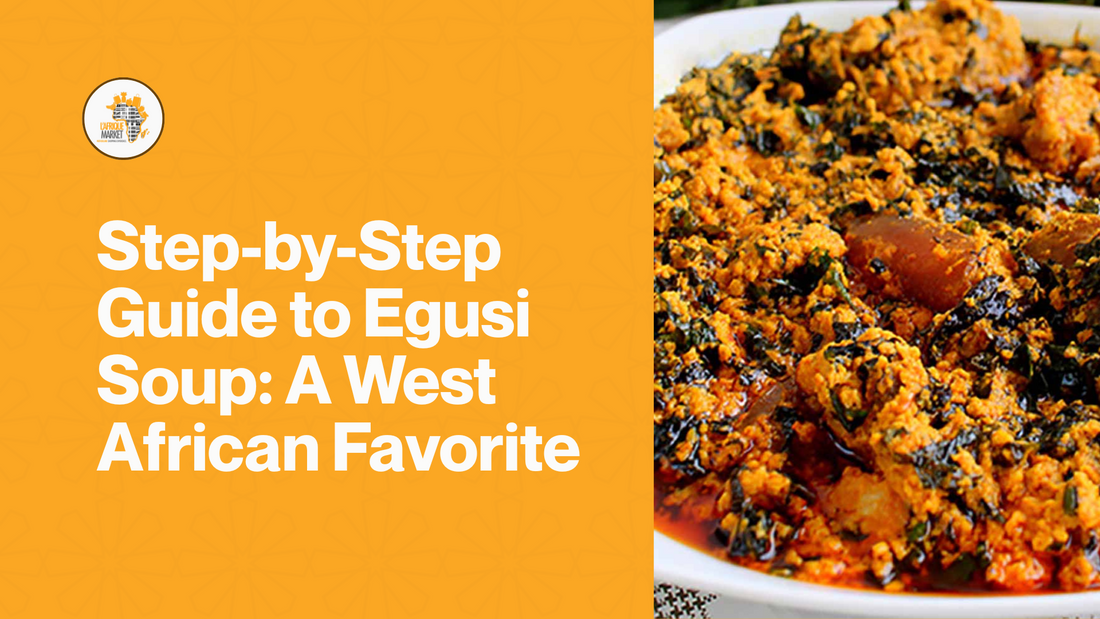
Step-by-Step Guide to Egusi Soup: A West African Favorite
Share
Egusi soup is a proud staple of West African cuisine, particularly within Nigerian homes and celebrations. Known for its thick, hearty texture and deeply nutty flavor, egusi soup is rich with culture, nutrition, and versatility. If you’re craving an authentic taste of West Africa, follow this comprehensive guide to understanding, shopping for, and mastering egusi soup, from its history to its final, mouthwatering spoonful.
What Is Egusi?
Egusi refers to the protein-packed, oil-rich seeds of certain melons (notably, Citrullus lanatus subspecies), which are dried and ground to produce the base of this signature soup. Recognized by different names in various regions (including "agushi" in Ghana), egusi soup is most famous in Nigeria, essential to feasts and everyday meals alike.

Image from: Sokokuu Africa
Health Benefits of Egusi Soup
- High in protein and healthy fats, thanks to the melon seeds.
- Packed with essential vitamins such as A, B1, B2, C, and minerals like magnesium, potassium, and calcium.
- Source of dietary fiber, supporting digestive health.
- When combined with assorted meats, fish, and leafy vegetables, egusi soup provides a balanced, nourishing meal.
Ingredients: What You’ll Need
All the following can be purchased at L’Afrique Market for maximum quality and authentic results.
Also read: Food Combinations That Help You Add Healthy Weight
Essential Ingredients
- Ground egusi seeds (melon seeds)
- Palm oil or red palm oil
- Assorted protein: beef, goat meat, tripe (shaki), cow skin (kpomo), stockfish, smoked or dried fish
- Crayfish powder (dried, ground crayfish)
- Fresh leafy greens: ugu (pumpkin leaves), spinach, bitterleaf, or kale
- Onion (chopped)
- Fresh hot peppers (scotch bonnet or habanero, to taste)
- Bouillon/seasoning cubes
- Salt

Image from: Immaculate Bites
Optional Additions
- Periwinkle, snails, mushrooms, or tofu for extra texture
- Ogiri (fermented locust bean), for depth of flavor
Step-by-Step: How to Make Egusi Soup
1. Prepare the Proteins
- Wash and season your preferred meats and fish. Combine in a pot with chopped onions, salt, and seasoning cubes.
- Boil on medium heat until tender, adding water as necessary to create a flavorful stock.
- Remove and set aside, reserving the stock for the soup base.
2. Make the Egusi Paste
- Mix ground egusi seeds in a bowl with a dash of water. Stir into a thick, smooth paste.
- For a richer flavor, some cooks add a tablespoon of ground crayfish to the mixture.
3. Sauté and Steam the Egusi
- Heat palm oil in a large pot on medium heat.
- Add chopped onions and sauté until fragrant and just golden.
- Gently spoon the egusi paste into the oil, spreading evenly without stirring for a few minutes to let it "fry" and form soft lumps (the "curd" method).
- Stir gently, allowing the paste to fry for 6–8 minutes, avoiding burning.
4. Build the Soup
- Gradually add reserved meat stock (and water, if needed) and continue stirring. The egusi will swell and absorb liquid, thickening the soup.
- Add the boiled meats, fish, crayfish powder, fresh peppers, and any additional protein of choice.
- Let the soup simmer for 10–15 minutes, so flavors meld and the oil rises to the surface.
5. Add Greens and Final Touches
- Wash and chop your chosen leafy greens.
- Add to the soup, along with more water if a lighter texture is desired.
- Adjust salt, seasoning cubes, and pepper to taste.
- Simmer another 5–10 minutes, until the greens are tender but vibrant.
6. Serve and Enjoy
- Ladle hot egusi soup into bowls. Traditionally, it’s served with "swallow" foods: pounded yam, fufu, eba (cassava), or semovita.
- Eat with your hands for the full West African experience!

Image from: Best Friend Pitch
Pro Tips for Perfect Egusi Soup
- Don’t skimp on oil: Palm oil is essential for flavor and color. However, adjust for dietary needs if desired.
- Consistency is key: Too much liquid will make the soup runny; too little, and it’ll be heavy. Find your preferred balance.
- For depth of flavor: Try the ogiri or locust bean addition.
- Spinach vs. ugu vs. bitterleaf: Choose your greens according to desired flavor—ugu is slightly sweet, bitterleaf adds a signature contrast, while spinach is mild and widely available.
- Make it vegetarian: Substitute assorted mushrooms and tofu for meat; use vegetable stock.
Ingredient Table
| Ingredient | Role in Soup | Notes |
|---|---|---|
| Ground egusi | Soup thickener, flavor | Adds protein, oil, and signature texture |
| Palm oil | Cooking medium, flavor | Gives color, authentic aroma |
| Meats/fish | Protein | Builds richness and savory flavor |
| Crayfish powder | Umami seasoning | Deepens savoriness |
| Leafy greens | Texture, nutrients | Use ugu, spinach, or bitterleaf |
| Onion & hot pepper | Base flavor, heat | Balances richness, adds aromatic depth |
| Seasoning cubes/salt | Taste enhancement | Customize to preference |
Frequently Asked Questions About Egusi Soup
What’s the best meat to use?
Goat meat and beef are most common, but chicken, turkey, or assorted offals (shaki, cow skin) are excellent alternatives.
Can I freeze egusi soup?
Yes. Allow to cool completely, portion into containers, and freeze for up to 1 month. Reheat gently for best results.
Is egusi soup spicy?
It can be, depending on the number of hot peppers you add. Adjust to your heat tolerance.
Where can I buy egusi and the other ingredients?
All ingredients are available fresh and of high quality at L’Afrique Market in Chicago.
Serving Ideas and Pairings
- Egusi soup is most elating when paired with pounded yam, eba, or amala.
- Enjoy as part of a family gathering, celebration, or as a wholesome weekday dinner.
- Pair with a refreshing malt drink or zobo (hibiscus tea) for a taste of home.
Why Shop at L’Afrique Market?
L’Afrique Market makes it easy to access top-quality egusi seeds, a broad selection of traditional proteins, fresh Nigerian-style greens, and all your African grocery staples. Friendly staff can help you find everything for your recipe and recommend twists to make your egusi soup truly your own.
